Vietnamese food is one of our favorite cuisines in the world. It’s a big reason why we often find ourselves in Vietnam, to satisfy our cravings for irresistible Vietnamese dishes like banh mi, bun bo hue, pho, and bun cha.
Personally, I’m much more into savory food but even I can’t resist the many delicious Vietnamese desserts that await you after every meal in Vietnam. From its colorful cakes and tasty puddings to its limitless array of Vietnamese sweet soups, there’s no shortage of delicious desserts to satisfy your sweet tooth in Vietnam.
Chè bắp and bánh chuối are my favorites but be sure to try as many of these popular Vietnamese desserts on your next trip to Hanoi, Ho Chi Minh City, or anywhere else in Vietnam.
VIETNAMESE DESSERTS QUICK LINKS
If you’re traveling to Vietnam and want to really dive into Vietnamese cuisine, then you may be interested in joining a food tour or taking a cooking class.
TOURS & OTHER SERVICES
- Vietnamese Food Tours: Food Tours in Vietnam
- Vietnamese Cooking Classes: Cooking Classes in Vietnam
- eSIM: Vietnam eSIM
Save This on Pinterest!
No time to read this article on Vietnamese desserts? Click on the save button and pin it for later!
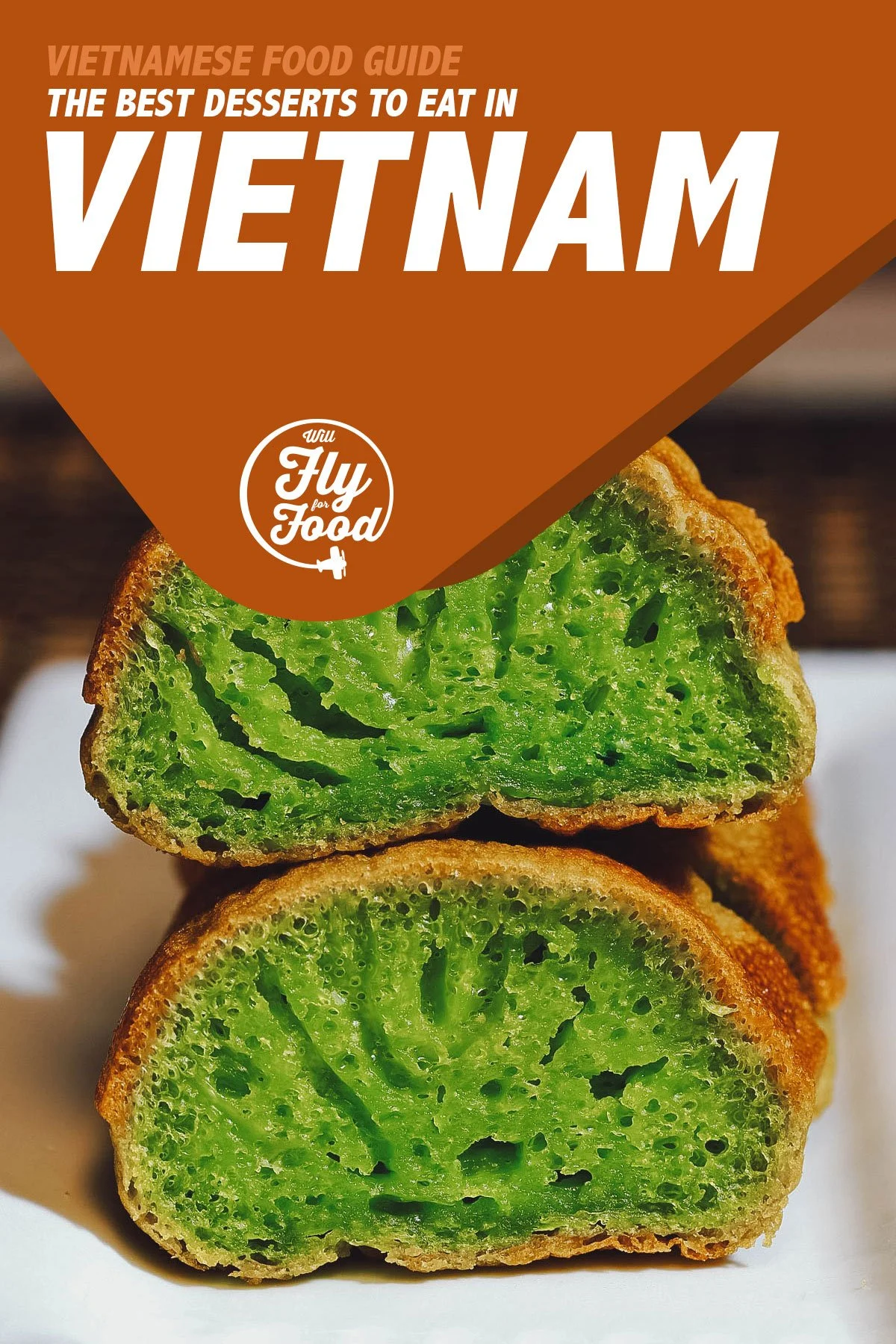
Photo by Le Do
MUST-TRY VIETNAMESE DESSERTS
1. Chè Ba Màu (Chè 3 Màu)
Chè ba màu (or chè 3 màu) literally means “three-color dessert” and is in reference to the three distinct layers that make up this popular Vietnamese dessert.
Chè ba màu is an eye-catching dessert made with three layers of different-colored ingredients like red kidney beans, yellow mung beans, and green pandan jelly. It’s a refreshing Vietnamese dessert that’s reminiscent of Filipino halo-halo. The ingredients are layered in a glass before being topped with crushed ice and a creamy coconut sauce.
Chè ba màu belongs to a family of Vietnamese desserts known collectively as “chè”. We’ll feature several in this guide but chè encompasses an array of Vietnamese desserts – mostly sweet soups and puddings – made with a wide variety of different ingredients.
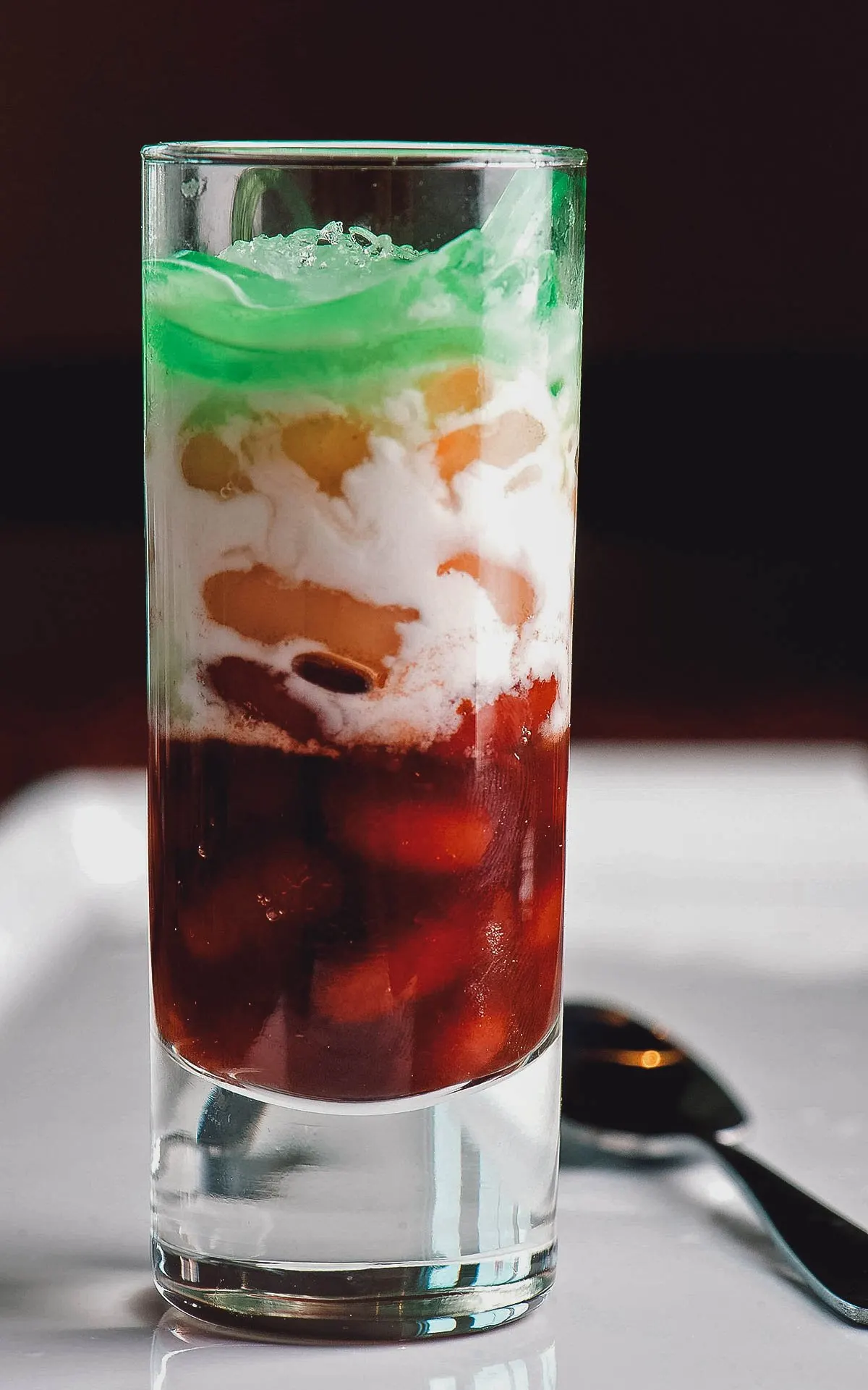
Photo by Marie Sonmez Photography
2. Chè Bà Ba
Chè bà ba is a type of che made with a soupy base of coconut milk filled with a variety of ingredients like taro, cassava, sweet potato, mung bean, and tapioca pearls. A specialty of southern Vietnam, it can contain over ten different ingredients and be served either hot or cold with ice.
Interestingly, the term bà ba refers to a type of Vietnamese garment that’s traditionally associated with rural southern Vietnam, which could point to the dessert’s roots. It may have been commonly sold by southern Vietnamese women wearing that type of dress.
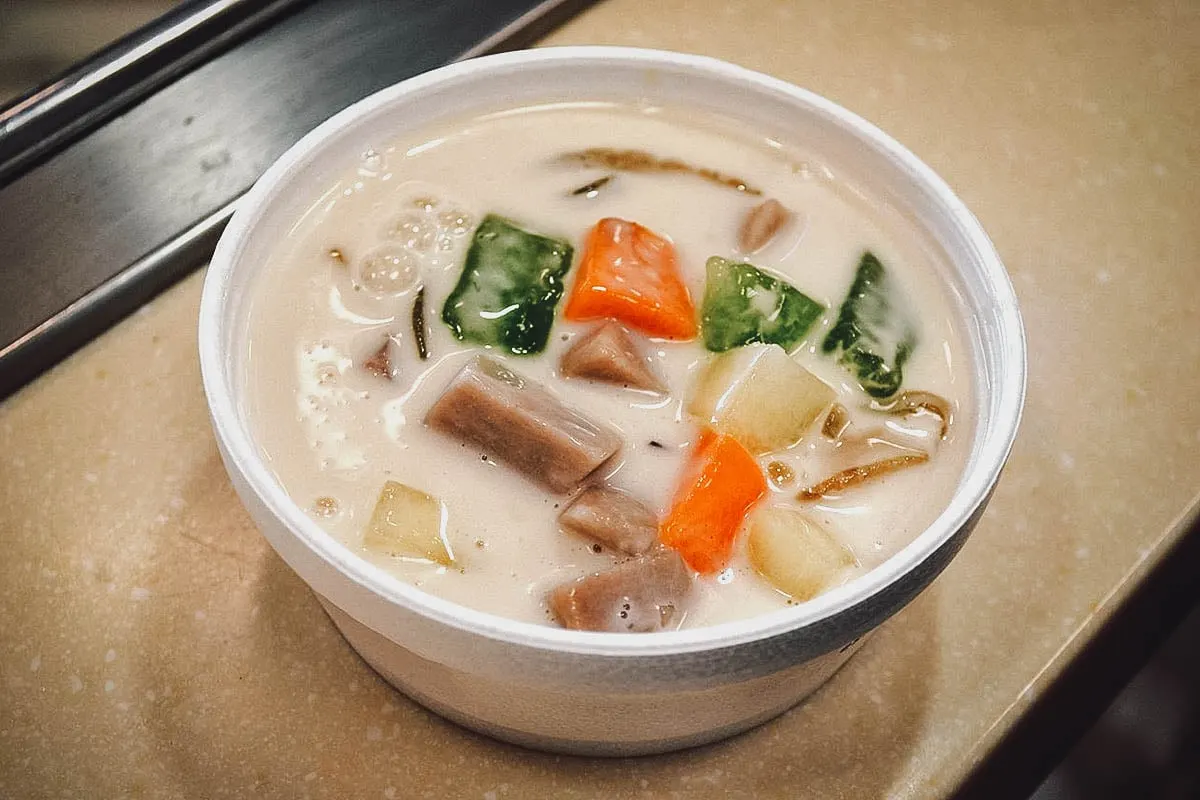
Photo by Zxcvasdfqwer888, CC BY-SA 3.0, via Wikimedia Commons / Processed in Photoshop and Lightroom
3. Chè Bắp
As described, chè bắp is one of my favorite Vietnamese desserts. It refers to a type of sweet corn pudding made with corn, glutinous rice, and coconut milk. This delicious Vietnamese dessert is available throughout the country but the best versions are said to come from central Vietnam, in cities like Hoi An and Hue.
I’ve enjoyed Vietnamese sweet corn pudding many times but the best version I’ve had thus far was made with Con Hen island corn. Con Hen is a tiny sliver of an island that’s said to produce the best corn in Hue.
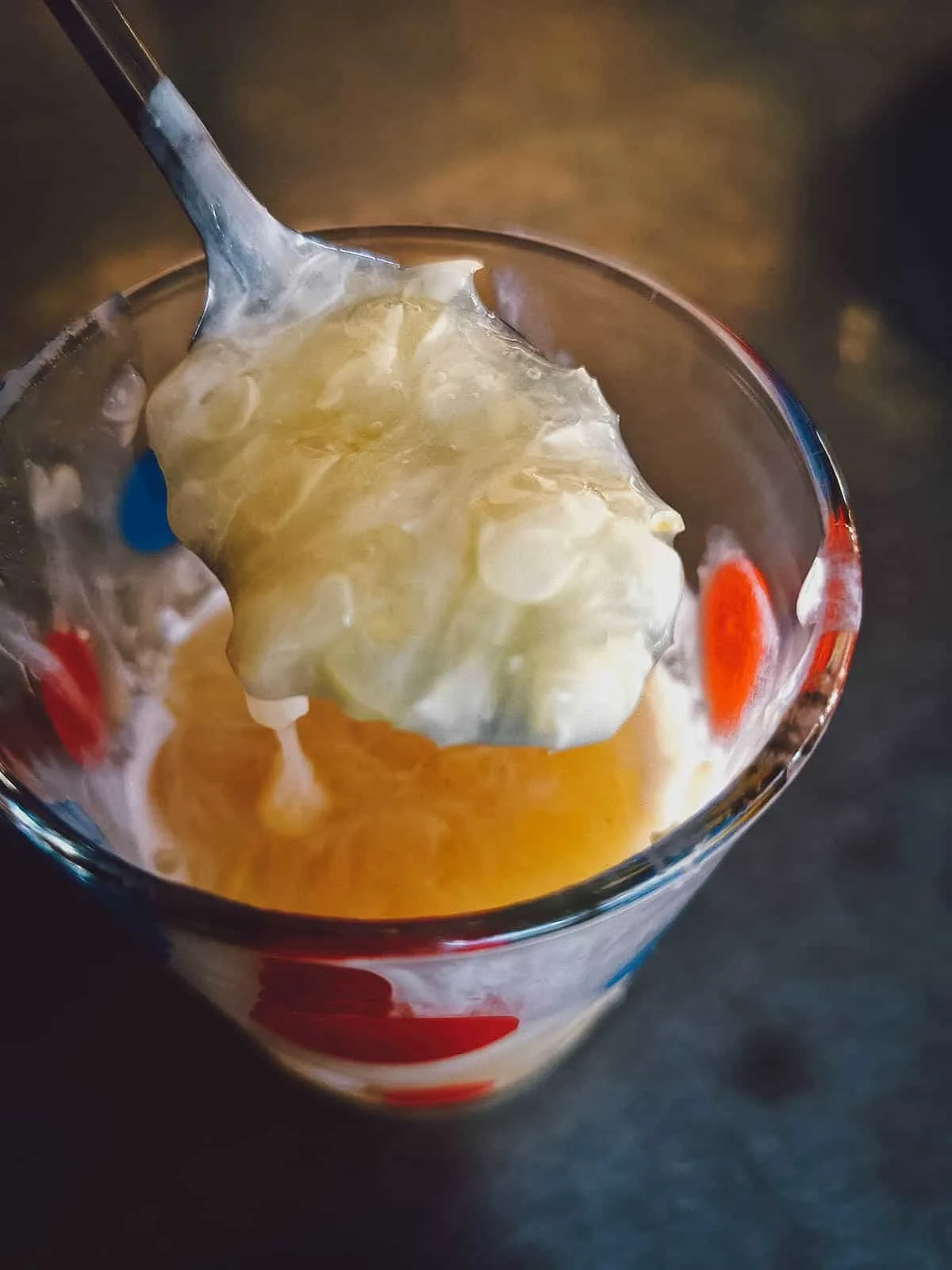
4. Chè Chuối
Chè chuối refers to another type of Vietnamese dessert pudding, this time featuring ripe bananas, tapioca pearls, and coconut cream. The dessert is flavored with pandan leaves and traditionally served warm or at room temperature, often with a sprinkling of lightly crushed roasted peanuts and sesame seeds on top.
According to this Vietnamese recipe blog, choosing the right bananas is key to making proper chè chuối. It’s commonly made with a type of Vietnamese banana called chuối sứ that needs to be at the right degree of ripeness for the perfect texture and sweetness.
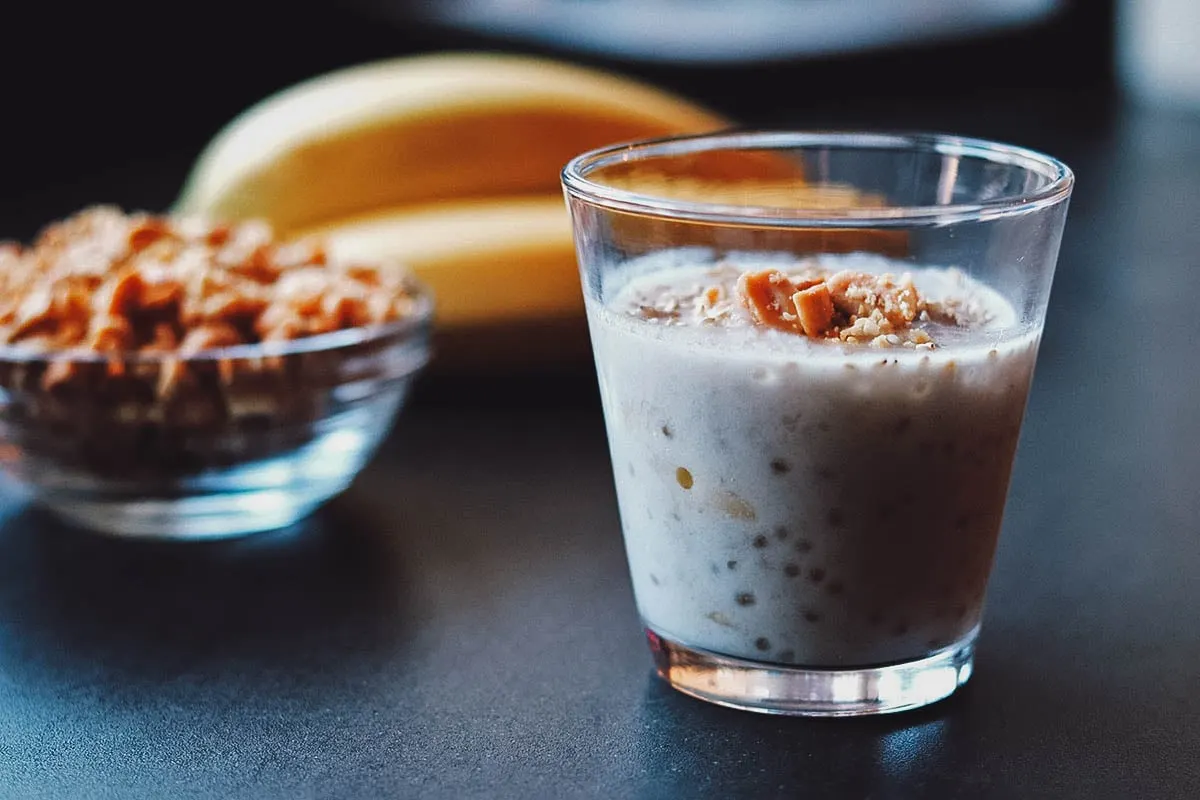
Photo by Yongxi
5. Chè Đậu Xanh
Chè đậu xanh is a Vietnamese dessert soup made with whole mung beans as its primary ingredient. Popular throughout Southeast Asia, the Vietnamese version of this classic mung bean dessert is flavored with coconut milk and sugar and can be made with other ingredients as well like aloe vera, seaweed, and sweet potato flour.
Chè đậu xanh can be enjoyed year-round though it becomes especially popular in the summer months, thanks to the perceived cooling properties of mung beans.
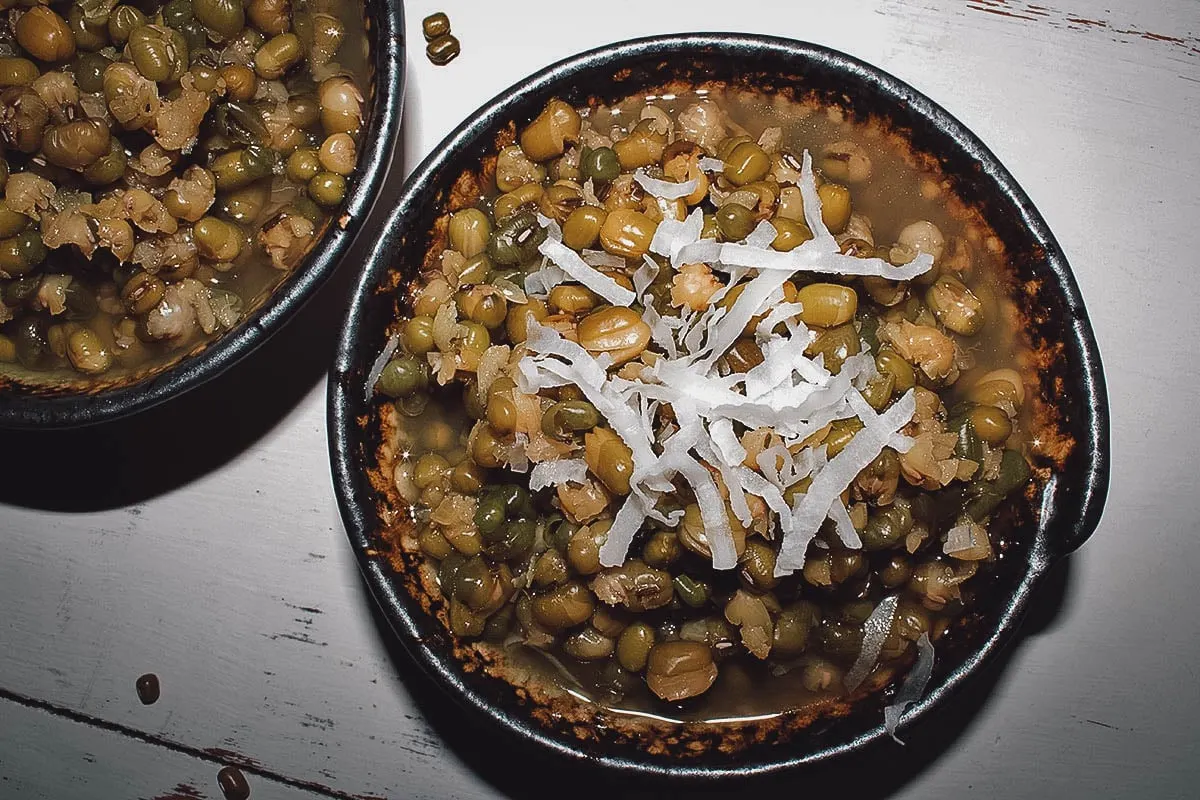
Photo by Simple_Vietnamese_Food
6. Chè Khúc Bạch
Chè khúc bạch literally means “white chunk dessert soup”, in reference to the flavored cubes of jellied milk used in this colorful Vietnamese dessert.
Made with gelatin and coconut milk (or fresh milk), the khúc bạch can be served as is or flavored with additional ingredients like pandan leaves, fruit syrup, and green tea. The jellied milk is sliced into wavy-looking cubes and then served in simple syrup with toasted almonds and a variety of fruits like longan, lychee, watermelon, and strawberry.
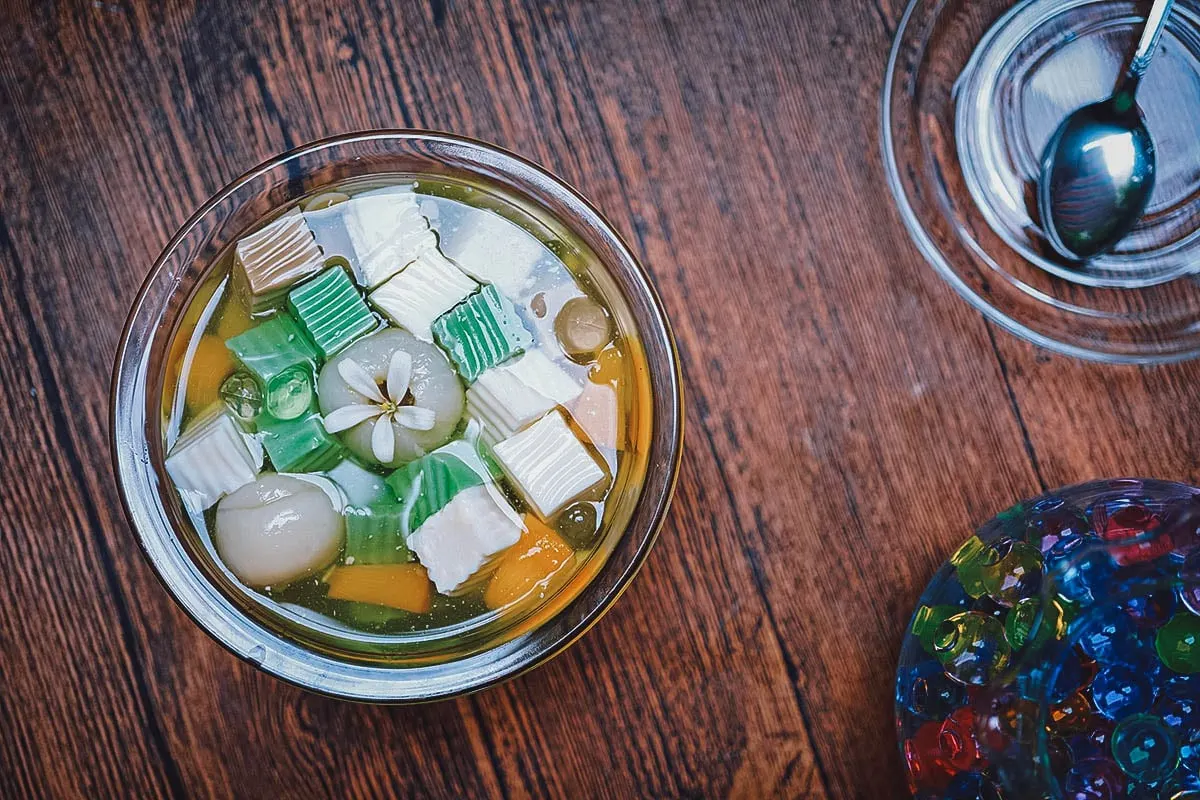
Photo by Logo400
7. Chè Thai
Chè thái is another colorful type of chè made with a variety of fresh fruit. It’s essentially a type of Vietnamese fruit cocktail made with different types of tropical fruit served with colorful jellies, crunchy water chestnuts, tapioca balls, and cold coconut milk.
Thanks to the use of water chestnuts and coconut milk in the recipe, chè thái is often referred to as the Vietnamese version of Thai tub tim grob. Like the Thai version, the water chestnuts are dyed red and coated in tapioca starch before boiling. This gives them a shiny ruby-like crimson hue, hence the nickname “red rubies”.
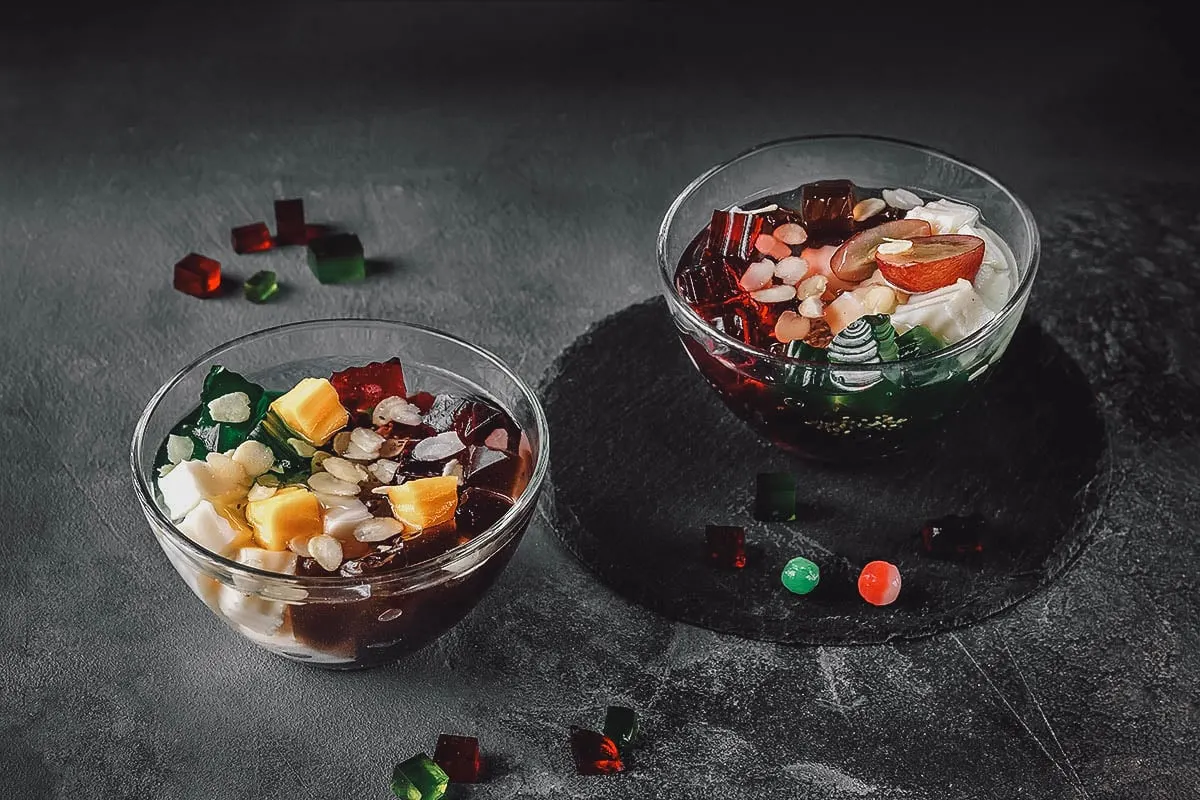
Photo by AlexLab
8. Chè Trôi Nước
Chè trôi nước is another colorful chè that’s a little different from the others already mentioned in this Vietnamese dessert guide. It’s different because it contains an ingredient that the others don’t have – dumplings.
Chè trôi nước consists of glutinous rice balls served in ginger syrup. The dumplings are filled with delicious mung bean paste and served in a clear or brown liquid made from water, sugar, and grated ginger root. A staple Tết (Vietnamese Lunar New Year) dish, it’s traditionally served warm and garnished with coconut milk (or coconut cream) and sesame seeds.
Chè trôi nước is also referred to as bánh chay in the north and chè xôi nước in the south. There’s no exact English translation but the name of the dessert loosely translates to “rice balls/dumplings float to the surface when cooked”.
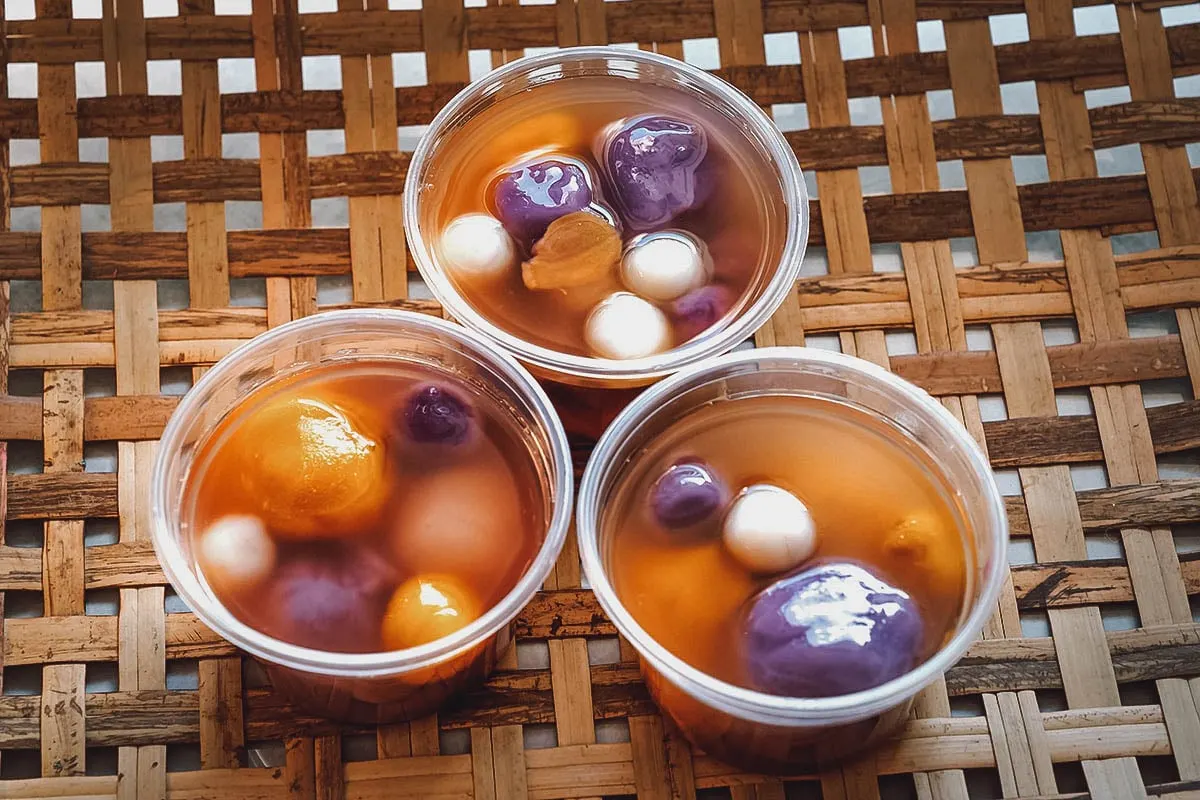
Photo by Quang nguyen vinh
9. Bánh Rán / Bánh Cam
If you’re a fan of Chinese dim sum, then you’re probably familiar with these deep-fried sticky rice balls. In Vietnam, they’re called bánh rán or bánh cam, depending on where you are in the country.
Like Chinese jiandui, the Vietnamese version of these crispy fried sweet snacks are made with glutinous rice flour shaped into balls. They’re filled with a sweetened yellow mung bean paste and coated with white sesame seeds.
In northern Vietnam, these mung bean pastry balls are referred to as bánh rán. The northern version is scented with jasmine flower essence and can either be coated in sesame seeds or poured over with a sugary syrup.
In the south, they’re referred to as bánh cam. Aside from the name, the southern version is different in that they’re flavored with vanilla extract instead of jasmine flower essence. They can also be made with freshly shredded coconut in the filling.
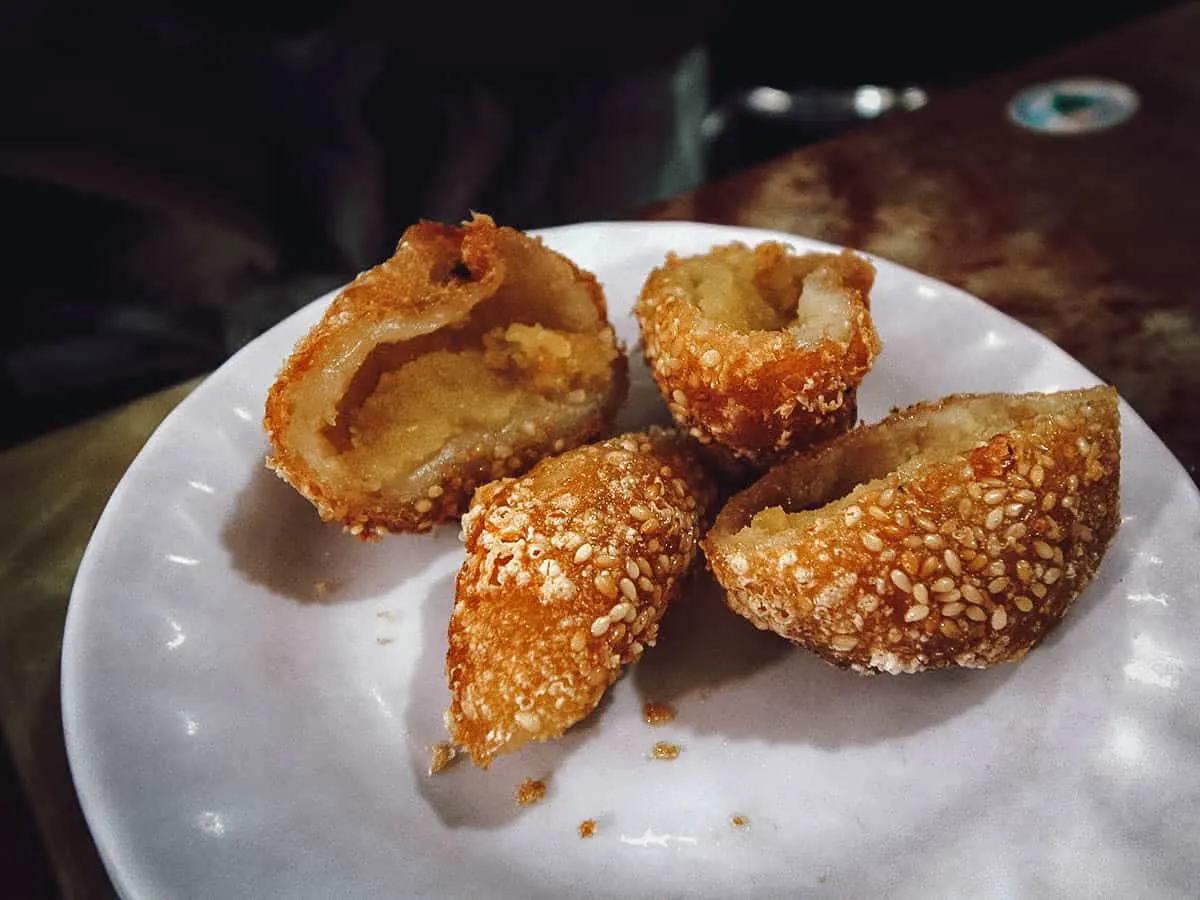
10. Bánh Chuoi
One of the most delicious desserts in Vietnam is bánh chuối, which literally means “banana cake”. It refers to a type of Vietnamese banana cake or bread pudding made with ripe bananas or plantains cooked with coconut milk, rice flour, condensed milk, sugar, and other ingredients. It can be baked (bánh chuối nướng), steamed (bánh chuối hấp), or fried (bánh chuối chiên).
Bánh chuối can take on different shapes and textures depending on how it’s made. Baked versions (pictured below) are cooked in an oven which gives them a crispy golden-brown exterior. Additional ingredients like white bread, eggs, butter, vanilla extract, and shredded coconut are included in some recipes, giving the cake a taste and appearance closer to bread pudding.
Steamed versions are made with the addition of tapioca starch while fried versions are less like cakes and more like banana fritters.
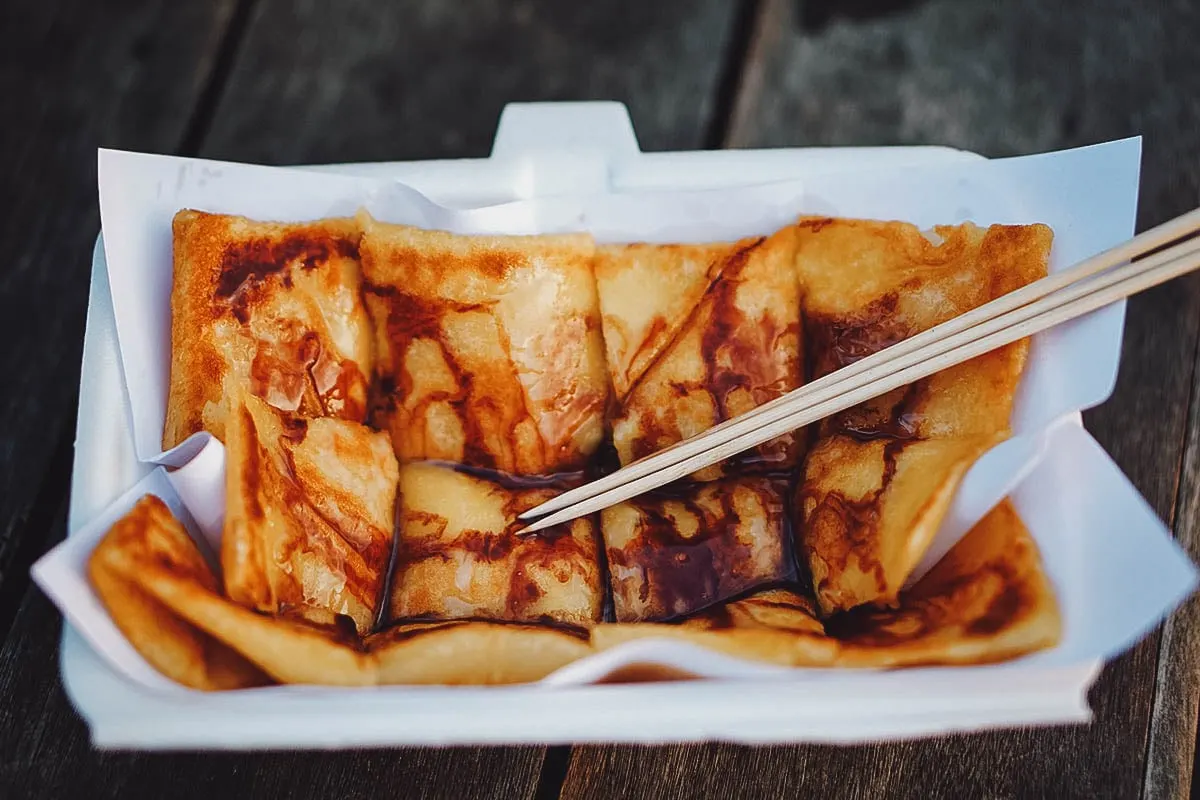
Photo by Tang Trung Kien
11. Bánh Đậu Xanh
Bánh đậu xanh is a Vietnamese dessert that hails from Hải Dương province in the north. Shaped like cubes and fudge-like in consistency, it’s a type of mung bean pastry that’s typically enjoyed as a snack with tea.
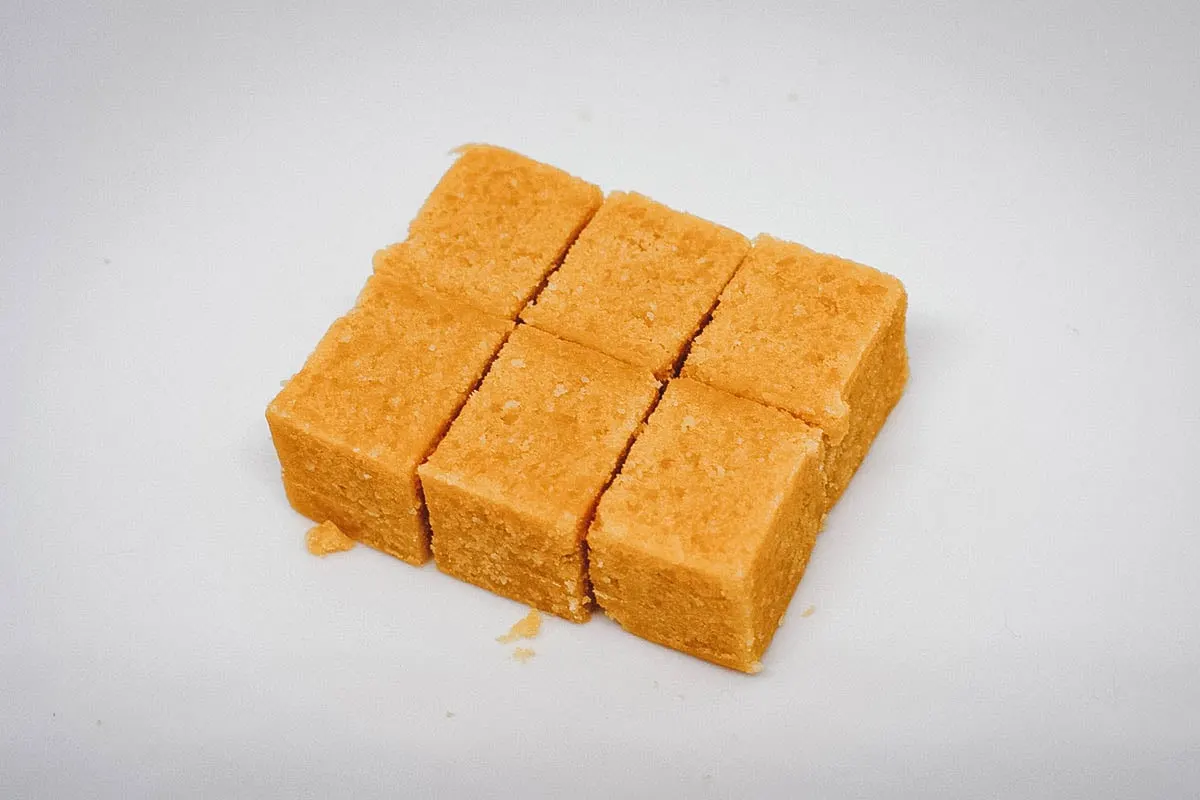
Photo by Truong Giang Huynh
12. Bánh Bo Nuong
This eye-catching Vietnamese sponge cake called bánh bo nuong is one of the most popular cakes in Vietnamese cuisine. It’s often referred to as Vietnamese honeycomb cake, thanks to its distinct honeycomb structure created by pockets of expanding gas.
Bánh bo nuong is made from a rice flour batter enhanced with tapioca starch and rich coconut cream. It can be flavored with different ingredients though it’s most often made with pandan, which gives the cake its vibrant green color and lovely aroma.
Bouncy in texture, this delicious Vietnamese sponge cake is traditionally served warm, either on its own or with a hot cup of tea.
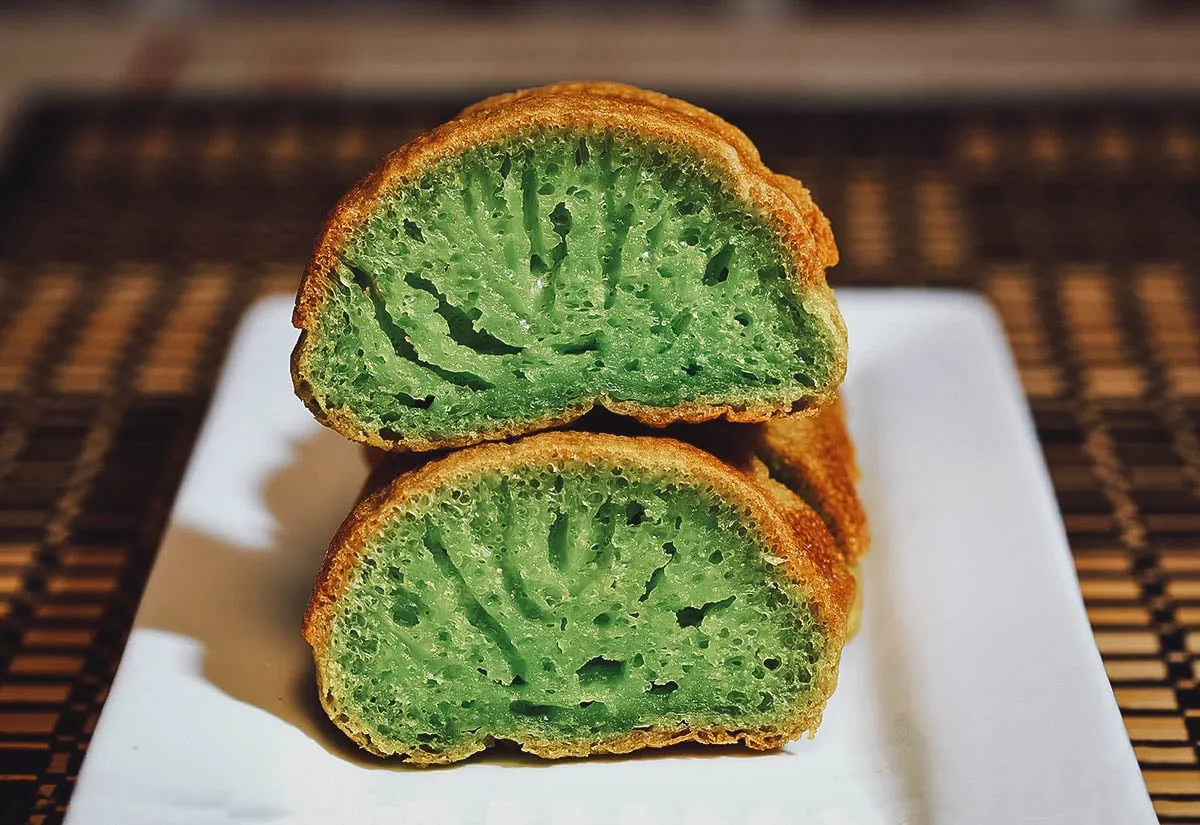
Photo by Le Do
13. Bánh Tieu
Deep-fried and puffy, bánh tieu refers to a type of Vietnamese yeasted doughnut. Hollow in the middle and much lighter than your typical western donut, bánh tieu donuts are encrusted in white sesame seeds and commonly sold as street food in Vietnam.
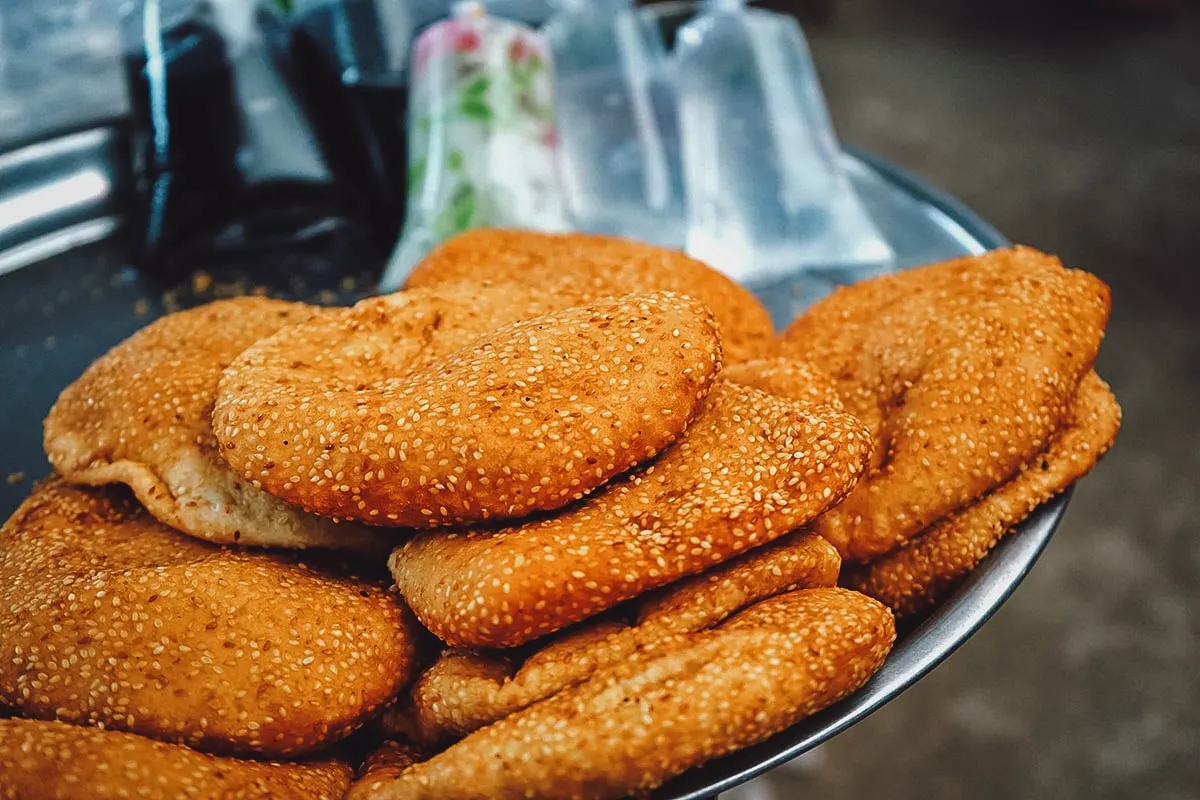
Photo by Moon Le
14. Bánh Trôi
If chè trôi nước (#8) sounded appealing to you, then you’ll probably want to try bánh trôi as well. Also known as bánh trôi nước, this tasty Vietnamese dessert consists of sticky rice dumplings filled with unrefined cane sugar known locally as đường phên.
Like chè trôi nước, bánh trôi gets its name from the way the balls float to the surface when cooked. They’re typically enjoyed with a sprinkling of toasted sesame seeds or freshly grated coconut.
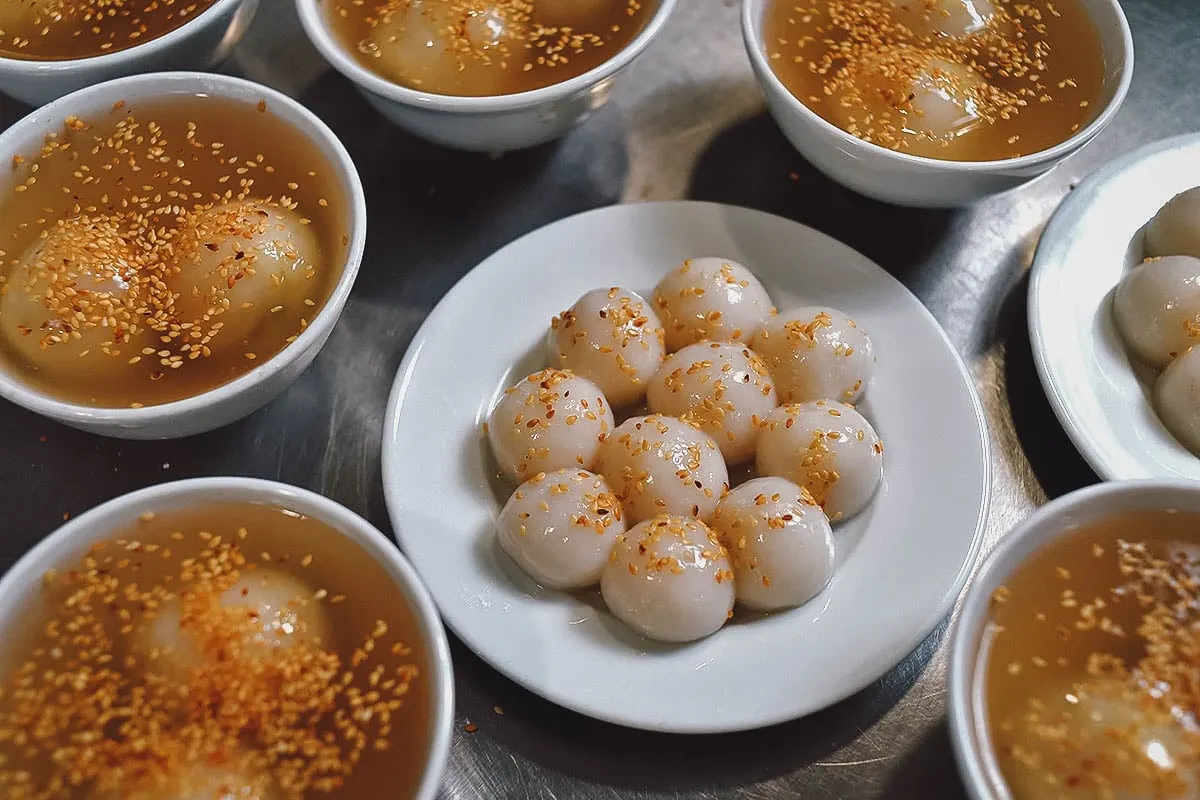
Photo by Huy Hoan
15. Bánh Trung Thu
The mooncake is a classic Chinese pastry that’s traditionally given as gifts and eaten during the Mid-Autumn Festival. There are many varieties of mooncake though they’re typically round in shape and made with a heavy lotus seed paste or red bean filling. The tradition of giving away mooncakes as gifts during the Mid-Autumn Festival is observed in Chinese communities throughout the world, including Vietnam.
In Vietnam, mooncakes are known as bánh trung thu, which literally means “mid-autumn cake”. The crust can be made with either baked wheat flour (bánh nướng) or roasted sticky rice flour (bánh dẻo).
Commonly used ingredients in Vietnamese mooncake fillings include mung bean paste, lotus seed, watermelon seed, dried sausage, and sugared lard. Bánh trung thu tends to be sweeter than other types of mooncake so salted egg yolk is often added for balance.
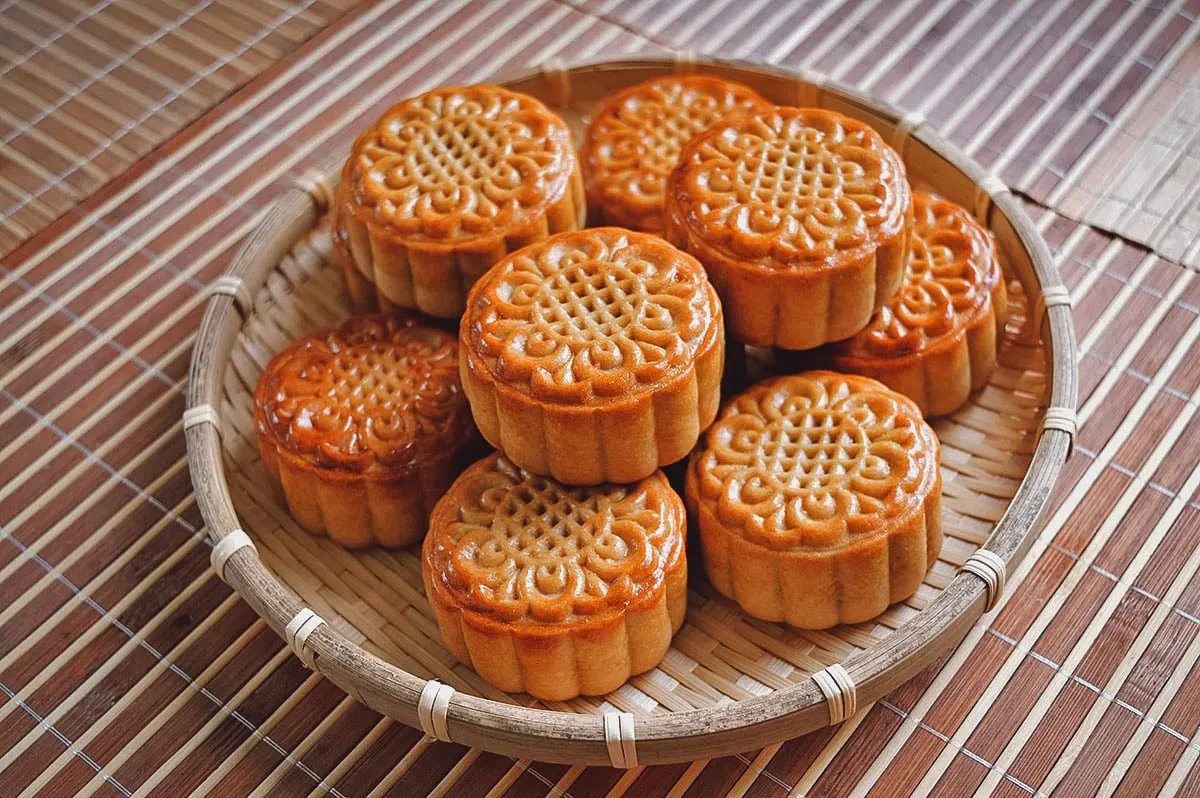
Photo by Thao Wagner
16. Xi Ma
If you’re drawn to interesting-looking food, then this black sweet pudding or soup will catch your eye in Vietnam. It certainly made our heads turn when we spotted a vendor selling it along the banks of the Thu Bon River in Hoi An.
Called xi ma, this thick dark pudding is made with black sesame, rice flour, coconut, sugar, and pennywort. Nutty and not too sweet, it’s served in small portions and is said to be good for your health.
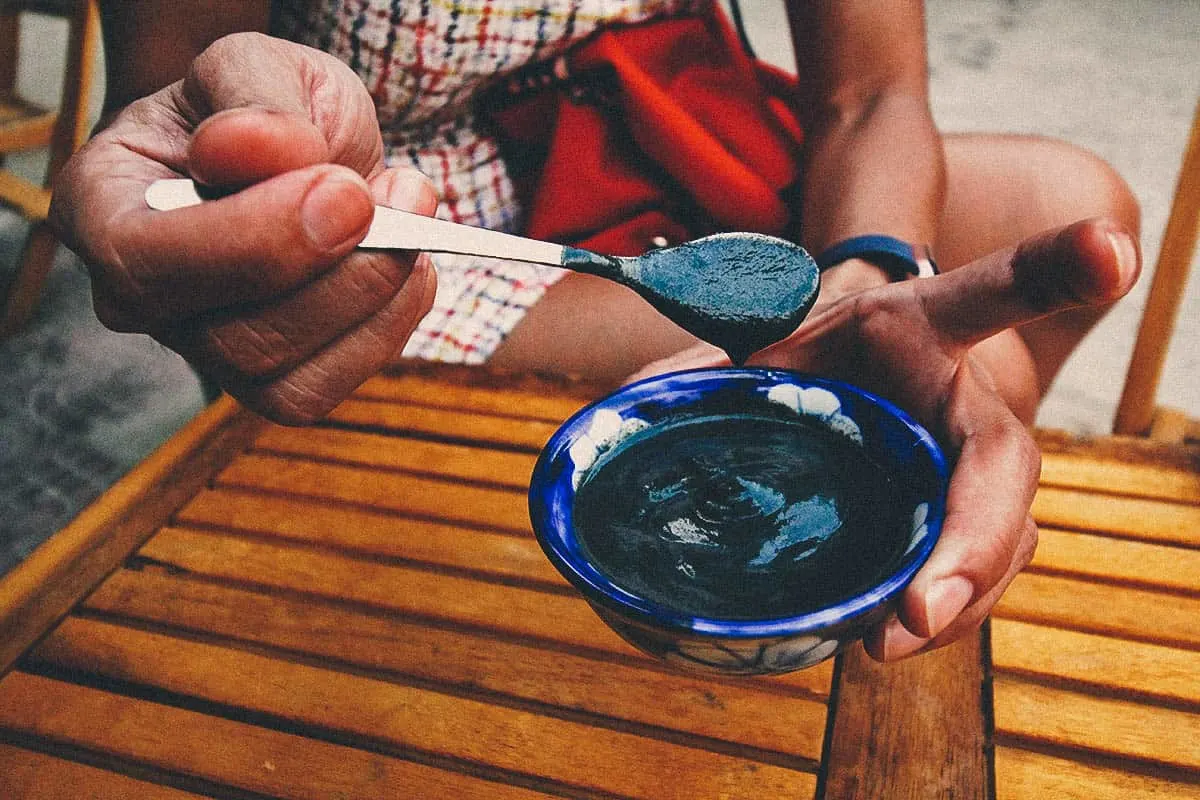
17. Khoai Mi Nuoc Cot Dua
If you like cassava, then you’ll definitely enjoy khoai mi nuoc cot dua. It’s a rich Vietnamese dessert made with chunks of boiled cassava served in a creamy coconut sauce. For more flavor and texture, the dessert is topped with freshly grated coconut, roasted sesame, and crushed roasted peanuts.
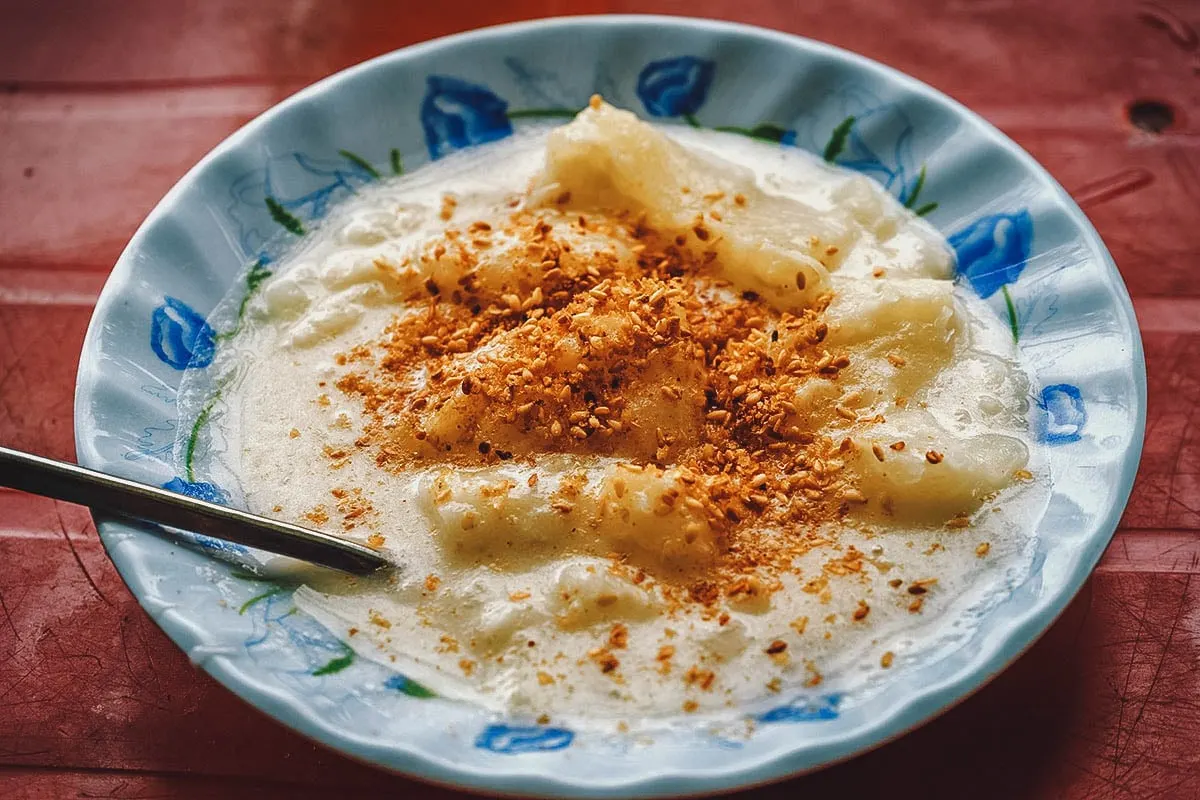
Photo by Nguyen Quang Ngoc Tonkin
18. Sua Chua Nep Cam
Sua chua nep cam refers to a simple but delicious Vietnamese pudding made with black sticky rice and yogurt. A beloved summertime treat, the glutinous black rice is flavored with palm sugar and pandan before being poured over with yogurt.
Depending on the person making it, sua chua nep cam can be enhanced with additional ingredients as well like condensed milk and honey. It can also be served with crushed ice.
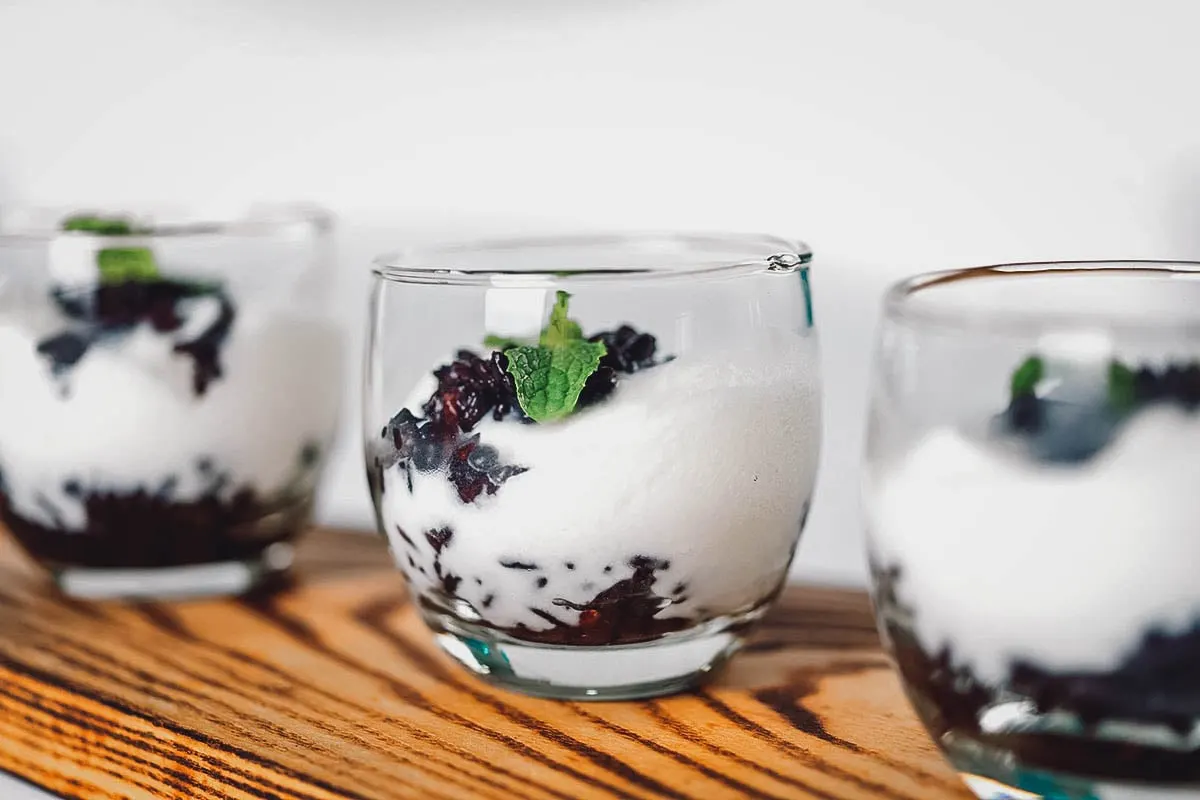
Photo by ngoc tran
19. Tau Hu Nuoc Duong
I grew up eating Filipino taho so it’s no surprise that tau hu nuoc duong – the Vietnamese version of Chinese douhua or silken tofu pudding – is one of my favorite Vietnamese desserts.
Silken tofu pudding is a popular snack or dessert that’s widely consumed throughout East Asia and Southeast Asia. It exists in many forms but in Vietnam, the silken tofu is typically served in a sweet and spicy ginger syrup.
I’m used to having my silken tofu with brown sugar syrup and tapioca pearls so the ginger syrup in this one gave me a nice jolt to clear out my sinuses.
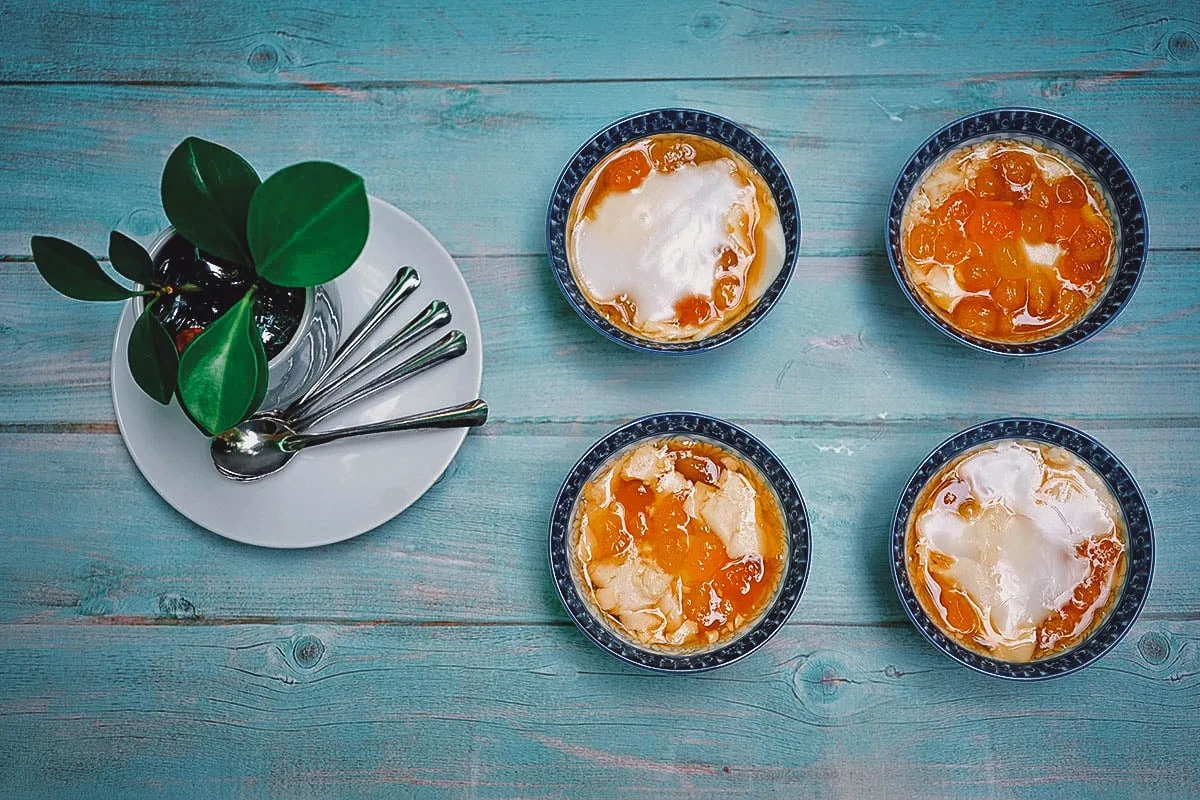
Photo by Logo400
20. Vietnamese Ice Cream
You’re already familiar with the awesomeness of Vietnamese food, but did you know that Vietnam is famous for its coffee as well? It’s true.
Like banh mi, coffee was introduced to Vietnam by the French in the 19th century. Today, Vietnam is the second largest producer of coffee in the world, behind only Brazil. Aside from black coffee or milk coffee, you can find interesting coffee concoctions in different parts of the country like egg coffee in Hanoi or salt coffee in Hue.
As good as the coffee is in Vietnam, it’s no surprise then that coffee beans are used as a flavoring in other dishes, most notably Vietnamese ice cream.
You’ll find many interesting ice cream flavors in Vietnam like coconut, durian, young sticky rice, and taro, but my favorite will always be coffee.
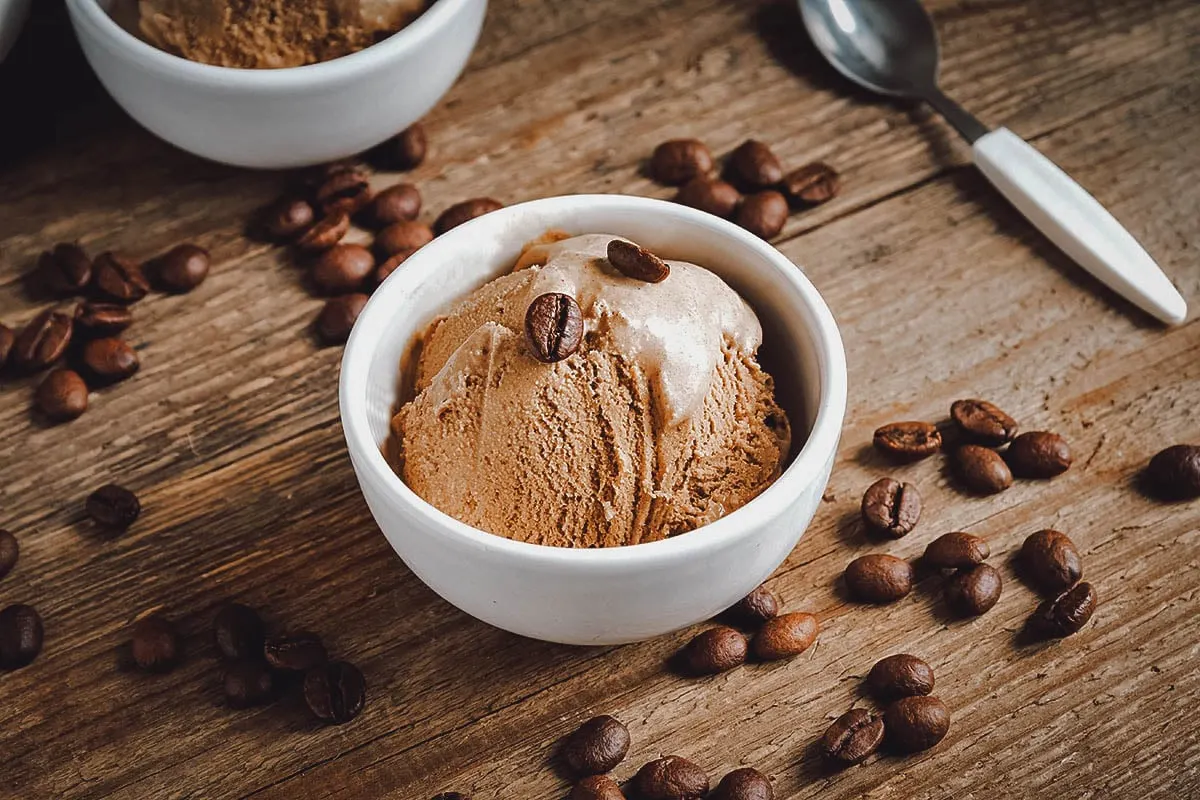
Photo by Oksana Mizina
FINAL THOUGHTS ON VIETNAMESE DESSERTS
Like I said at the top of this article, savory Vietnamese food is my jam but I can never say no to Vietnamese desserts, especially since many of them are so light.
If you could try just one dessert, then I suggest going for chè. It’s the most popular Vietnamese dessert and something you’ll find in some form no matter where you are in Vietnam.
Chè may be easy to find but deciding which one to try first is considerably more difficult. Like Malaysian kuih, there are dozens if not hundreds of Vietnamese desserts with the prefix chè so deciding which one to go for can be very confusing!
If you have a hard time deciding like I do, then just ask the vendor for their recommendations.
Disclosure
This article on Vietnamese desserts contains affiliate links. If you make a purchase, then we’ll earn a small commission at no additional expense to you. As always, we only recommend products and services that we use ourselves and firmly believe in. We really appreciate your support as this helps us make more of these free travel and food guides. Thank you!
Cover photo by Logo400. Stock images via Shutterstock.


Thien
Thursday 25th of January 2024
I’ve had all of these except for #11. I want to eat them all again but idk where to get them